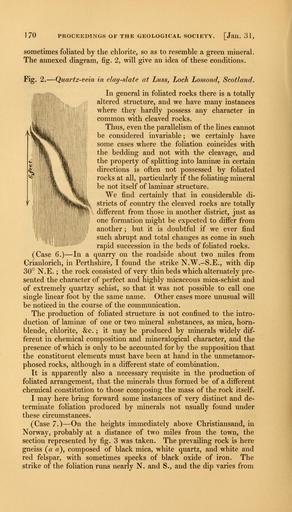MAKE A MEME
View Large Image

| View Original: | The_Quarterly_journal_of_the_Geological_Society_of_London_(12711862804).jpg (1828x3200) | |||
| Download: | Original | Medium | Small | Thumb |
| Courtesy of: | commons.wikimedia.org | More Like This | ||
| Keywords: The Quarterly journal of the Geological Society of London (12711862804).jpg 170 <br> PROCEEDINGS OF THE GEOLOGICAL SOCIETY Jail 31 <br> sometimes foliated by the chlorite so as to resemble a green mineral <br> The annexed diagram fig 2 will give an idea of these conditions <br> Fig 2 ” Quartz-vein in clay-slate at Luss Loch Lomond Scotland <br> In general in foliated rocks there is a totally <br> altered structure and we have many instances <br> where they hardly possess any character in <br> common with cleaved rocks <br> Thus even the parallelism of the lines cannot <br> be considered invariable ; we certainly have <br> some cases where the foliation coincides vrith <br> the bedding and not with the cleavage and <br> the property of splitting into laminae in certain <br> directions is often not possessed by foliated <br> rocks at all particularly if the foliating mineral <br> be not itself of laminar structure <br> We find certainlv that in considerable di- <br> stricts of country the cleaved rocks are totally <br> \ different from those in another district just as <br> one formation might be expected to differ from <br> another ; but it is doubtful if we ever find <br> such abrupt and total changes as come in such <br> rapid succession in the beds of foliated rocks <br> Case 6 ” In a quarry on the roadside about two miles from <br> Crianlorich in Perthshire I found the strike N W -S E with dip <br> 30° N E ; the rock consisted of very thin beds which alternately pre- <br> sented the character of perfect and highly micaceous mica-schist and <br> of extremely quartzy schist so that it was not possible to call one <br> single linear foot by the same name Other cases more unusual will <br> be noticed in the course of the communication <br> The production of foliated structure is not confined to the intro- <br> duction of laminae of one or two mineral substances as mica horn- <br> blende chlorite c ; it may be produced by minerals widely dif- <br> ferent in chemical composition and mineralogical character and the <br> presence of which is only to be accounted for by the supposition that <br> the constituent elements must have been at hand in the unmetamor- <br> phosed rocks although in a different state of combination <br> It is apparently also a necessary requisite in the production of <br> foliated arrangement that the minerals thus formed be of a different <br> chemical constitution to those composing the mass of the rock itself <br> I may here bring forward some instances of very distinct and de- <br> terminate foliation produced by minerals not usually found under <br> these circumstances <br> Case 7 ” On the heights immediately above Christiansand in <br> Norway probably at a distance of two miles from the town the <br> section represented by fig 3 was taken The prevailing rock is here <br> gneiss a « composed of black mica white quartz and white and <br> red felspar with sometimes specks of black oxide of iron The <br> strike of the foliation runs nearly N and S and the dip varies from 35614742 110213 51125 Page 170 Text v 11 http //www biodiversitylibrary org/page/35614742 1855 Geological Society of London Biodiversity Heritage Library The Quarterly journal of the Geological Society of London v 11 1855 Geology Periodicals Smithsonian Libraries bhl page 35614742 dc identifier http //biodiversitylibrary org/page/35614742 smithsonian libraries Information field Flickr posted date ISOdate 2014-02-23 Check categories 2015 August 26 CC-BY-2 0 BioDivLibrary https //flickr com/photos/61021753 N02/12711862804 2015-08-26 20 51 54 cc-by-2 0 PD-old-70-1923 The Quarterly journal of the Geological Society of London 1855 Photos uploaded from Flickr by Fæ using a script | ||||